Wylfa is the biggest prize in Welsh history
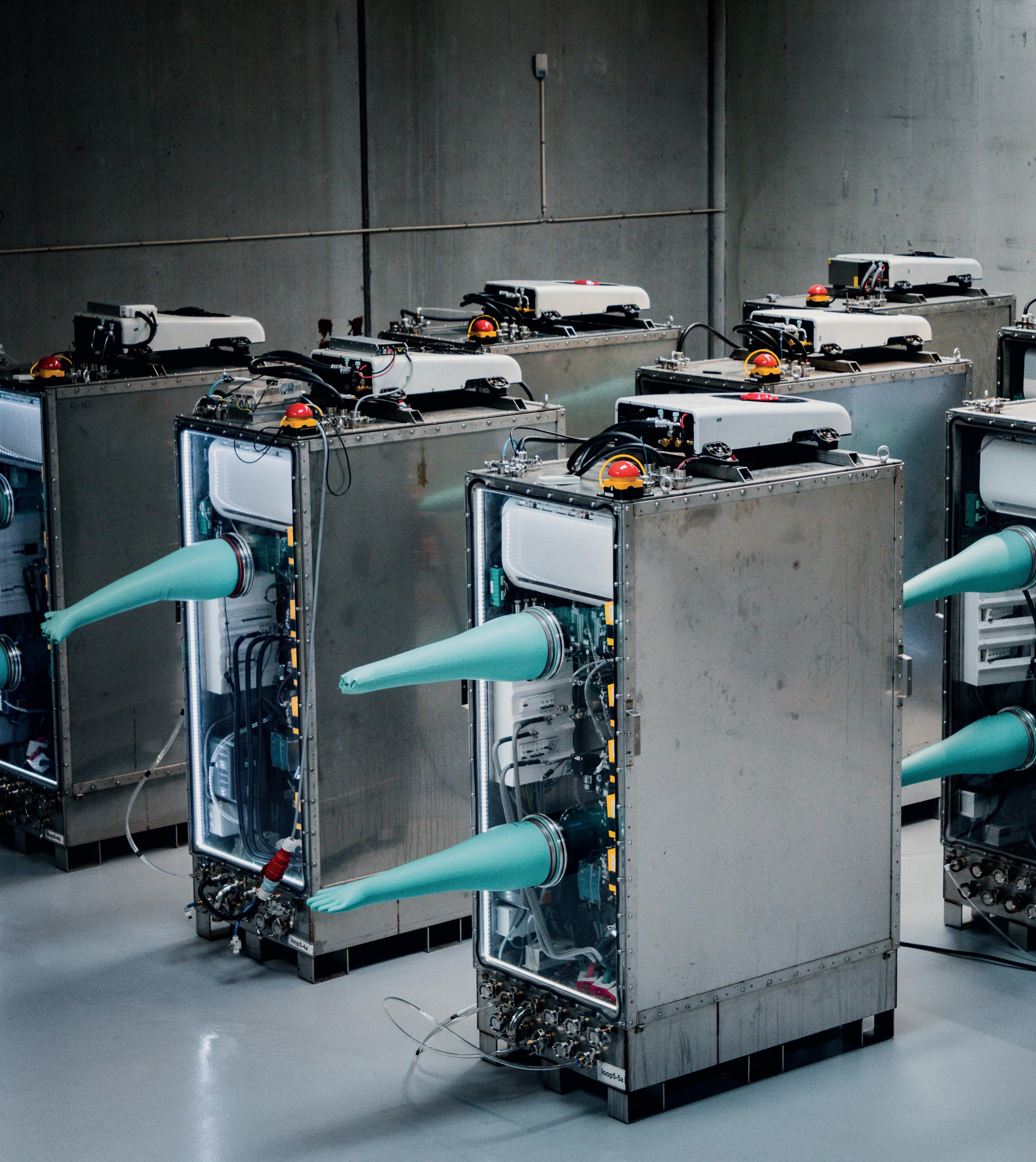
A programme emerges
Reflections on a decade of delivery in Cumbria
Partnership delivers for energy sector
PAGE 22 PAGE 2 PAGE 16 PAGE 8
/ 2024
FOR
UK NUCLEAR INDUSTRY
SPRING
THE MAGAZINE
THE


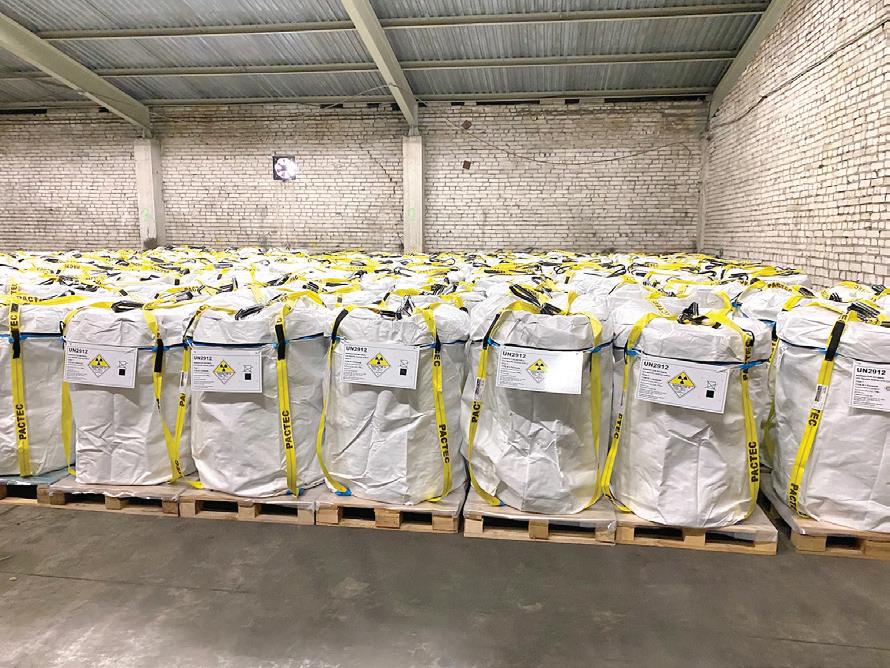







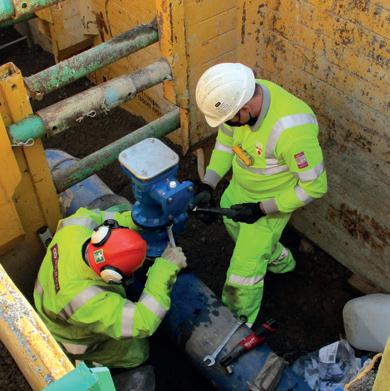

Decommissioning Active Pipelines
Applications to immobilise contamination within pipes, ducts, and voids prior to cutting and disposal.
Design & Development of bespoke solutions to improve safety and reduce cost when conducting nuclear decommissioning.
A growing portfolio of successful projects in the nuclear decommissioning industry worldwide.

Over 30 Years’ Experience Cost Saving Solutions
Remote Application Solutions Reduces Operator Exposure

Type IP-1 LiftPac® Type IP-1/IP-2 Drum OverPac® Innovative LLW Packaging from Call us: +44 01946 695005 Our commitment to industry needs keeps us on the forefront of product developmentconsistently earning us patents, and resulting in continuously improved products for our nuclear clients 7A Type A IP-3 LiftPac® Type IP-2 LiftPac® 01225 864 864 . stevevick.com

Welcome to the first Industry Link of 2024 and boy has it been a busy start to the year. Genuinely, I can’t remember a more relentless period of big ticket nuclear announcements… since last year that is.
There is the shiny nuclear roadmap for us to get excited about, a plan of action for how we add a lot (and I mean a lot) more nuclear to the system by 2050. ‘A programme emerges’ writes the NIA’s CEO, Tom Greatrex, as he analyses its worth.
A plan is also emerging for what is one of our prime nuclear sites: Wylfa. I assess the enormous opportunity of a new project there after Great British Nuclear said it would be buying the site. Its shaping up to be an important year for new projects…
Naturally, projects need people and the NSSG’s Beccy Pleasant shares her thoughts on how we deal with the huge challenge in meeting the growing demand for skills and staff.
Elsewhere there is a fascinating piece by Martin Walkingshaw who assesses how NWS is making the UK’s nuclear waste permanently safe; Copenhagen Atomics looks back at a memorable UK industry delegation trip to see its Denmark headquarters; and Prof. Richard Neilson explores the advent of AI in decommissioning.
It’s another jam-packed issue… I hope you enjoy.
Iolo James Head



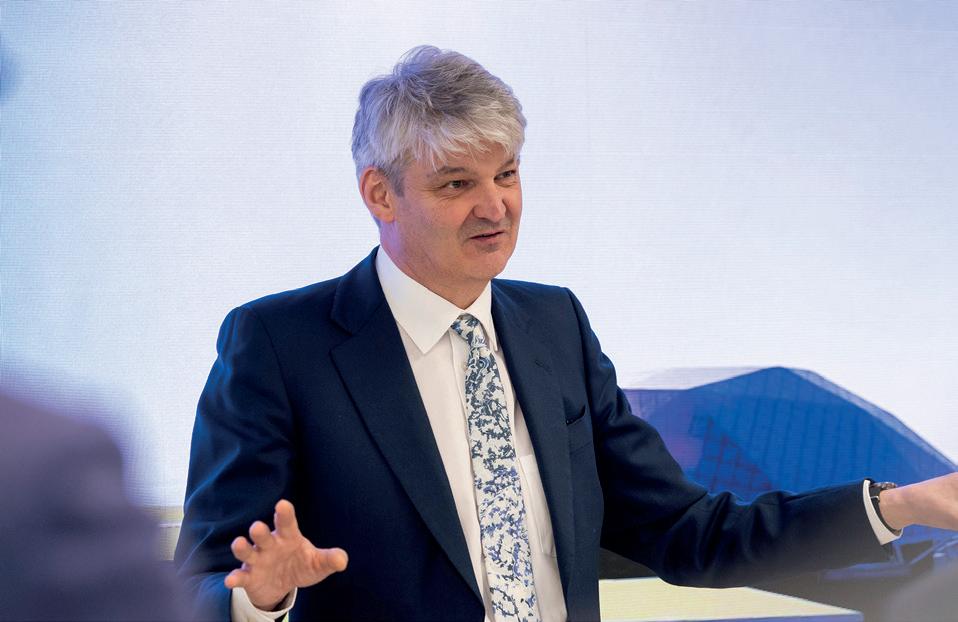
18
of Communications, Editor WELCOME TO Editor - Iolo James Art Editor - Dan Powney Press & Advertisement Enquiries - press@niauk.org Membership Enquiries - membership@niauk.org Contributors - Tom Greatrex • Lincoln Hill • Great British Nuclear • Beccy Pleasant, Nuclear Skills Strategy Group • Richard Neilson, National Decommissioning Centre • Michael Drury, UK Atomics • Eldon Garnett, Morgan Sindall Infrastructure • Sir Stephen Lovegrove, Rolls-Royce SMR • Martin Walkingshaw, Nuclear Waste Services • with additional thanks to World Nuclear News Nuclear Industry Association is a company limited by guarantee registered in England No. 2804518 Registered Office - 5th Floor, Tower House, 10 Southampton Street, London WC2E 7HA TEL +44(0)20 7766 6640 EMAIL info@niauk.org Cover image - Courtesy of Copenhagen Atomics copenhagenatomics.com This magazine is printed on 100% post-consumer recycled paper, using vegetable based inks. NEWS FROM THE HUB. 26 IN THIS ISSUE••• PAGE 4 PAGE 10 14 PAGE 7 PAGE 20 NWS MAKING THE UK’S RADWASTE PERMANENTLY SAFE, SOONER NSSG SET FOR EXCITING YEAR OF DELIVERY INDUSTRY TRIP TO COPENHAGEN Paving the way to the biggest expansion of nuclear power

A programme emerges
Since the publication of the Energy Security Strategy, with the high level target of up to 24GW of nuclear capacity by 2050, in welcoming the ambition, on behalf of the Nuclear Industry Association (NIA) I have repeatedly argued that what is needed to achieve that ambition at pace, with the highest levels of efficiency and effectiveness and to maximise the domestic industrial and economic input is a programme.
A programme that gives clarity of scale, timeframes and with a serious consideration of the public policy requirements to underpin delivery. The publication of the government’s Nuclear Roadmap takes us several steps closer to that programme.
The headline commitment, to explore a further large-scale project after Sizewell C, meaning that “the UK will look to deploy both SMRs and further large-scale nuclear in parallel over the next decade, providing the supply chain the certainty it needs to invest in skills and local communities” should end the absurd pretension that we should build 24 GW (and more) with just large or just small nuclear. We need them both to maximise likely sites and our expertise.
Even more significant is the end of the “one at a time” approach to nuclear projects, which was in danger of becoming a very bad (and expensive) habit. Parallel developments, and overlapping construction periods, will provide the demand to keep our workforces mobilised, to train more people, to invest in more capacity and better capabilities, and to keep our project management expertise sharp and fresh.
The Roadmap goes further with an intention to approve between 3 and 7 GW of nuclear capacity every five years from 2030 to 2044. That sends an important signal to industry that for the next 20 years, the UK plans to maintain a regular drumbeat of projects. Ensuring a programmatic approach provides greater clarity and predictability, which in turn enables supply chain investment and more

2 — SPRING | 2024 TOM GREATREX • CHIEF EXECUTIVE • NIA
UK content in the future fleet: two decades’ worth of work at least is enough to make career choices, train new people, and invest in equipment.
We all know, though, that setting targets is not the same as pouring concrete. That said, two further things in the Roadmap, in particular, should help us pour concrete sooner (and smarter).
The first is the mandate to the Office for Nuclear Regulation and Environment Agency to “maximise the use of overseas regulatory assessment” and to endorse “greater collaboration and sharing of expertise across regulatory bodies that are assessing the same technology on a similar timeframe.” As the unprecedentedly close work of our industry bodies and governments over the last couple of years demonstrate, not only are we and our allies all striving toward the same goal of net zero with energy security and economic prosperity, but we also recognise the best route to delivery at pace and scale lies in collaboration.
Making the most of each other’s work, avoiding duplication and reducing the design variations and anomalies that get in the way of efficient construction and supply chain operation.
The second step is that “investors and developers of new nuclear projects will be able to engage with government on the suitability of Contract for Difference (CfD) and Regulated Asset Base (RAB) financing models.” Opening up the RAB beyond projects with a UK reference plant will help more projects access cheaper financing and a broader pool of capital. We all know that financing is by far and away the leading obstacle to nuclear projects getting off the ground, and the biggest chunk of the costs the consumer pays at the end. If we can make that cheaper, faster and more certain, we will build more units more quickly and for a better price of electricity at the end.
The job is by no means done of course. We still urgently await Sizewell C reaching a Final Investment Decision. Whatever plans we have
beyond Sizewell C, we have no programme unless the second project gets started. At least we know where two of the next projects will likely be with the Chancellor’s announcement that the Government is to buy the Wylfa and Oldbury sites. A positive move, but there is work to be done.
Likewise, we keenly await not only GBN’s SMR selections, but also the conclusion of contracts with the successful parties. Similarly, it has been ten months since the Chancellor promised that nuclear would be classified as environmentally sustainable, subject to consultation, and still we await that consultation. These tasks should not be left to the next Parliament, because time is not free, and political bandwidth, even of a new Government, is not unlimited.
I am acutely aware that as the UK is in all likelihood within months of a general election, almost everything is seen through the prism of a possible change of government later this year. It is important to note that the Labour Party’s comments in reaction to the Roadmap underline that not only is there consensus support for the need for new nuclear capacity to meet our energy security and decarbonisation challenges—but there is a desire for that to be done with pace, whichever party is in government at the end of the year.
There is more in the Roadmap publication on fuel security, on planning, on a smarter regulation challenge and more besides.
My consistent, and insistent, view that nuclear has a vital and integral role to play in a clean, reliable and secure energy future is summed up in the Roadmap thus: “the only current form of reliable, secure, low carbon electricity which can be deployed at scale in the UK.” If we pursue the substance and the spirit of this document with confidence and vigour, we can renew and expand that contribution for the generations to come. That is why the day the Roadmap was published was—another—good day for nuclear in the UK.
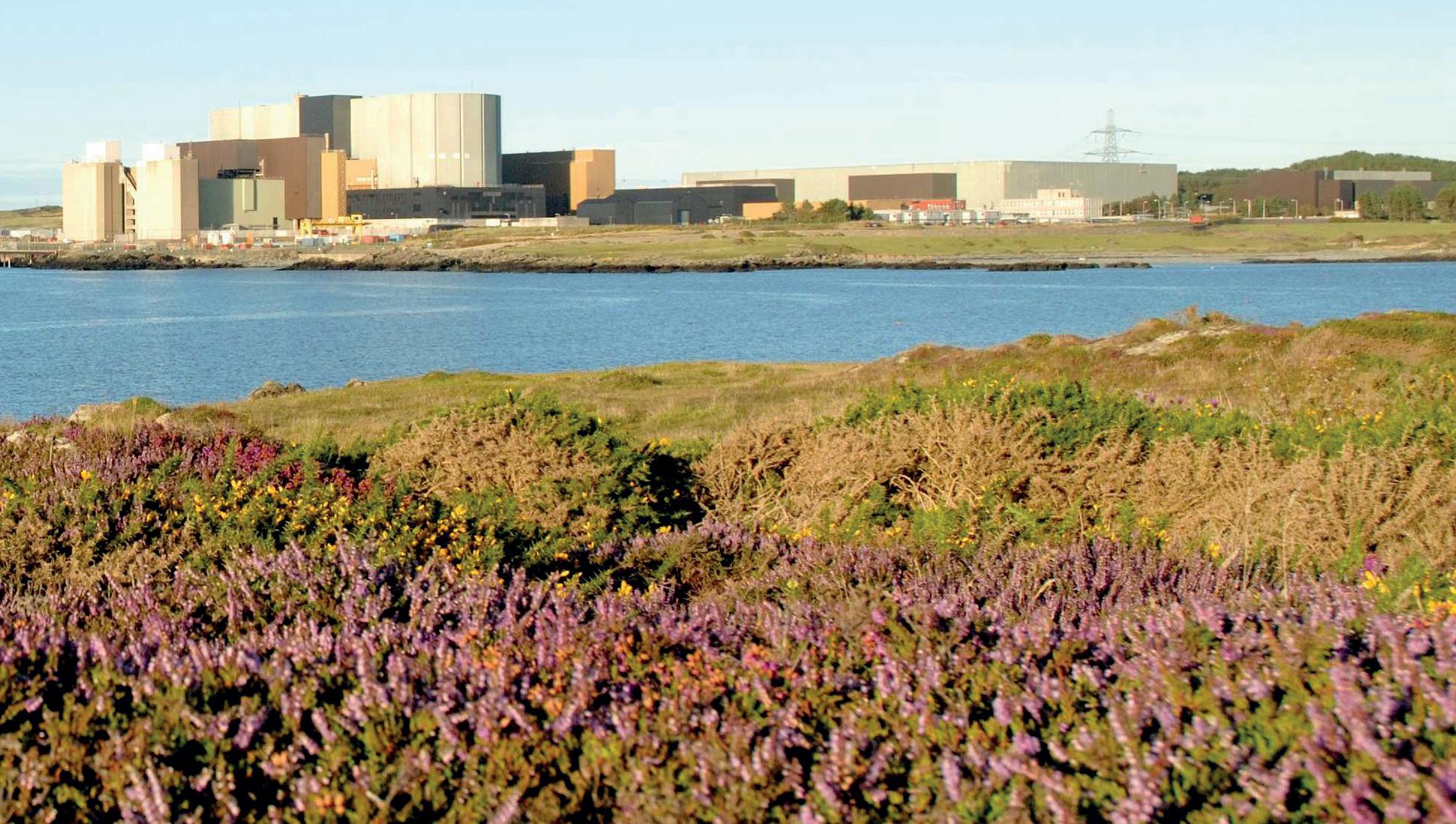
2024 | SPRING — 3
GBN UPDATE: SITES, TECHNOLOGY SELECTION AND THE CIVIL NUCLEAR ROADMAP
It’s been a busy few months for Great British Nuclear (GBN), the organisation tasked by the Government to implement its new nuclear programme. So, where are we now and what’s likely to be next?
Nuclear sites
The most widely commented on announcement was that GBN is buying land for new nuclear development from Hitachi at both Wylfa in Ynys Môn/ Anglesey and Oldbury-on-Severn in Gloucestershire. Announced in the Budget in March, this purchase is due to close in June. GBN has purchased these sites to support the government’s nuclear ambitions, and decisions on the projects to be deployed at the sites will be made as site characterisation work develops and technology choices are made.
Wylfa and Oldbury have tremendous potential and present a significant opportunity for Britain and for local communities. Each location has a long history of hosting the UK nuclear industry and has experienced the enormous benefits that nuclear power can bring to their local and regional economies. Hitachi’s development of these sites and their work to date was one of the reasons why they were so attractive.
GBN is setting out to work closely with the local communities at these sites to consider how future new nuclear projects will benefit their communities. Engagement has started already, both with stakeholders and the local communities, and there will be further updates over the coming months as the ongoing Small Modular Reactor (SMR) technology selection process and the government’s broader nuclear programme develop.
SMR technology selection
GBN has also announced that the six companies in its SMR Technology Selection Process can now access tender documentation, allowing them to bid for potentially multi-billion-pound technology development contracts. The technology vendors in the process—EDF Energy, GE-Hitachi Nuclear Energy International LLC, Holtec Britain Limited, NuScale Power, Rolls-Royce SMR and Westinghouse Electric Company UK Limited—will now have until June to submit their tender responses. GBN will assess these responses and negotiate final contracts, prior to the targeted announcement of successful bidders later in 2024. Successful bidders’ technologies will be allocated to sites and incorporated into projects, and bidders will receive funding to develop their technology.

The timeline GBN is on is hugely ambitious— the fastest that has been done in the market to date globally—and is aimed not just at speed, but to deliver a robust and successful procurement process that delivers value for the taxpayer.
The Civil Nuclear Roadmap
Earlier this year, the government published their Civil Nuclear Roadmap, setting out plans to boost the UK’s energy security and achieve net zero carbon emissions with up to a quarter of Britain’s energy produced from nuclear power by 2050. Access to nuclear sites is a critical factor in achieving these nuclear ambitions, which included deploying SMRs and exploring a further large-scale reactor project after Hinkley Point C and Sizewell C.
GREAT BRITISH NUCLEAR
CIVIL NUCLEAR: ROADMAP TO 2050
▲ The civil nuclear roadmap sets out the government’s vision for a dynamic civil nuclear sector. Visit gov.uk/government/ publications/civil-nuclear-roadmap-to-2050
In addition to a world-leading competition to generate secure, low carbon power from SMRs, the publication of the roadmap starts providing the industry with a framework to work to in the future. It outlines how the country will boost generation of clean and reliable nuclear energy to up to 24 gigawatts (GW) by 2050. This would be enough to provide a quarter of the UK’s electricity needs, through securing 3-7 GW worth of investment decisions every five years from 2030-2044 on new nuclear projects. The roadmap provides a timeline for when the next steps for exploring a large-scale power plant as big as Sizewell in Suffolk or Hinkley in Somerset will be communicated.
The Civil Nuclear Roadmap provides a framework for GBN to help deliver more safe, clean, and affordable UK nuclear power to UK consumers. Together with industry, we will enthusiastically take up the role the Government has set out for us in delivering and advising across the UK’s nuclear programme. We are actively building GBN’s capability to take on the challenge ahead.
Great British Nuclear is an arms-length body with the vital role of driving delivery of new nuclear projects on behalf of Government, will stand ready as part of its advisory role to support the Government in designing future policy.

Media Watch
The big nuclear news so far this year was the release of the Civil Nuclear Roadmap to 2050 and to give an idea of how much interest there was in the story the Nuclear Industry Association’s (NIA) Chief Executive, Tom Greatrex, was quoted in 23 separate news outlets including Sky, BBC, The Telegraph and Utility Week. He welcomed the roadmap saying “we will need both large and small nuclear at scale and at pace for our energy security an net zero.”
The Chancellor announcing the Government would purchase the Wylfa and Oldbury nuclear sites from Hitachi was one of the bigger news lines to come from his Budget in March, probably because it was a bit unexpected. The talks between Great British Nuclear and the Japanese company had seemingly been leaked to the Financial Times a few weeks prior, but that didn’t stop several outlets covering the story. That included the very popular Daily Post paper in north Wales, which quoted the NIA’s line that this was a ‘pivotal moment’ in its headline.
In January the NIA CEO Tom Greatrex appeared on the German TV news programme Today in Europe on ZDF. With an average audience of 4 million it’s a popular show in a country which in recent times has turned its back on nuclear. He reminded the audience that countries are turning back to nuclear after periods of neglect: “What we are increasingly seeing is that countries that said they would no longer build new nuclear power plants have changed their minds. We’re seeing this in France, the Czech Republic and also in Poland.”
As Brussels welcomed world and industry leaders for the first ever Nuclear Energy Summit in March, the Financial Times produced a special report on the state of the industry globally. One story looked at cost overrun and delays. NIA Chief Executive Tom Greatrex told the paper that repetition enables costs to come down with each new plant built as lessons are learned and supply chains recover from a stop-start approach to the technology. “The best way to reduce build costs is to replicate and, crucially, achieve design maturity before construction,” Tom said.
When the Government announced its intention to develop new gas-fired power stations to boost electricity supplies, the NIA’s Director of Policy and External Affairs responded in the media by saying this was “the inevitable consequence of not investing in nuclear quickly and early enough. On days like today with gas accounting for 50 per cent of the electricity mix. We lack the clean, firm power we need when the weather is against us.”
Believe or not, but the UK has spent £7 billion over the past two years in balancing the power grid. It’s a large bill which is ultimately borne by electricity consumers and is the price we all pay for relying on expensive gas to fill gaps in power generation. We care about balancing costs because with more nuclear on the bars these costs would be lower due to less need to buy the gas. It’s something the NIA team has been tracking for several years and recently our work was featured in the City AM paper.
2024 | SPRING — 5
IOLO JAMES • HEAD OF MEDIA & COMMUNICATIONS • NIA
E03017841 ISBN 978-1-5286-4560-7
January 2024 CP 1009 Department for Energy Security & Net Zero
Economic impact of nuclear highlighted
The nuclear energy industry in southeast USA generates an annual economic impact of almost $43 billion, supporting 152,598 jobs and generating $13.7 billion in labour income, says a study released by the Southeast Nuclear Advisory Council.
The study presents a comprehensive analysis of the economic impacts of the nuclear energy sector in the fivestate region consisting of Georgia, the Carolinas, Tennessee and Virginia.
Nuclear power constitutes 37% of utility-scale net electricity generation in the region, compared with the national average of 19%. The region hosts 25 of the USA’s 93 operational nuclear reactors with a comprehensive network of companies, universities, and national laboratories supporting the industry and contributing to a skilled workforce.
Feasibility for AP1000s at Borssele
Westinghouse has been awarded a contract by the Dutch government to conduct a technical feasibility study on deploying two AP1000 reactors at the Borssele nuclear power plant site.
In December 2021, the Netherlands’ new coalition government placed nuclear power at the heart of its climate and energy policy. Based on preliminary plans, two new reactors will be completed around 2035 and each will have a capacity of 1000-1650 MWe. The two reactors would provide 9-13% of the Netherlands’ electricity production in 2035.
Kyoto Fusioneering and UKAEA sign collaboration agreement
UKAEA and the private Japanese fusion technology company Kyoto Fusioneering signed an agreement aiming to advance tritium breeding blanket technology from its conceptual stage towards commercialisation.
The Communication Framework Agreement also paves the way for future collaboration on tritium fuel cycle, remote handling and power conversion technologies. A breeding blanket is a component to be used in fusion machines, mainly used for producing tritium which is one of the fuels of fusion reactors.
The new agreement follows another the two signed in March 2023.Kyoto Fusioneering has also worked on the development of gyrotron technology for UKAEA’s MAST-U fusion machine at its base at Culham.
AECL, AtkinsRéalis to collaborate on advanced Candu design
An MOU will see the two companies collaborate on deployment of Candu reactors in Canada and internationally and expand their intellectual property licensing agreement, and is to be followed by further agreements to accelerate the development of the Candu Monark reactor technology.
AtkinsRéalis unveiled plans for the 1000 MW Candu Monark, a Generation III+ reactor with the highest output of any Candu technology, last November, saying the new design would build on the commercial success of currently operating Candu units and decades of design development to offer amongst other things a higher output, improved cost per megawatt-hour, and a longer operating life of 70 years.
All of Canada’s operating reactors are Candu units. The PHWR design was developed by AECL, in cooperation with Canadian industry, from the late 50s onwards and the first commercial unit began operation in 1971. According to WNA information, today there are some 27 Candu power reactors operating in seven countries.
AtkinsRéalis is the original equipment manufacturer of CANDU technology with a Canadian supply chain of more than 250 companies.
6 — SPRING | 2024
visit www.world-
For full versions and more details on these and other stories
nuclear-news.org

NSSG set for exciting year of delivery
The next twelve months promises to be an exciting and challenging time for the UK nuclear industry, as it steps up efforts to meet the huge projected rise in demand for skills and staff over the coming decades.
The scale of the challenge is clear and so is the need for action. According to analysis by the Nuclear Skills Strategy Group (NSSG), demand for staff is set to rise by 93 per cent over the next 20 years, with 355,000 staff needed to enter the sector.
The nuclear industry currently employs 83,000 people but by the end of the decade the sector is expected to grow to 123,000 staff. This means 132,000 must be recruited by 2030—taking into account people retiring or moving to other sectors—or around 16,000 per year. The sector faces an immediate shortfall of 10,000 full-time equivalent roles.
Based on these projections, the workforce is set to peak in 2043 at 161,000 staff. The anticipated recruitment which must take place to respond to sector growth and staff attrition over the next 20 years is 333,000 employees.
While these forecasts reflect the medium to longterm, work to address this need must begin now— driven by the nuclear sector’s huge potential for energy security, not to mention its role in meeting the UK’s ambitious net-zero targets. Taking this all into consideration, the stakes could not be higher.
For this reason, the NSSG is leading an ambitious industry-wide skills programme which, by March 2024, will deliver the following:
● Destination Nuclear, an ambitious campaign aimed at attracting people into the nuclear sector
● A sector wide jobs portal, directing people from Destination Nuclear
● Four bootcamp programmes to boost competency in our most critical skill areas
● A tutor training scheme to meet the rising demand for courses
● A cross-sector leadership training programme to help retain our best leaders
● Regional hubs and training networks to ensure education and skills provision meets future demand (with a national coordinating body to standardise career pathways and curriculums to support movement within the sector)
We have known this skills challenge was coming for some time so it’s really positive everyone has woken up to the need to properly invest in interventions to ensure we have the people available to drive the exciting future for nuclear that will keep our energy secure.
There is a huge amount to do, but an ambitious programme has been developed and the delivery of this has commenced, which will ensure that we can get there. It’s a really exciting time to be working on developing skills for the nuclear sector.
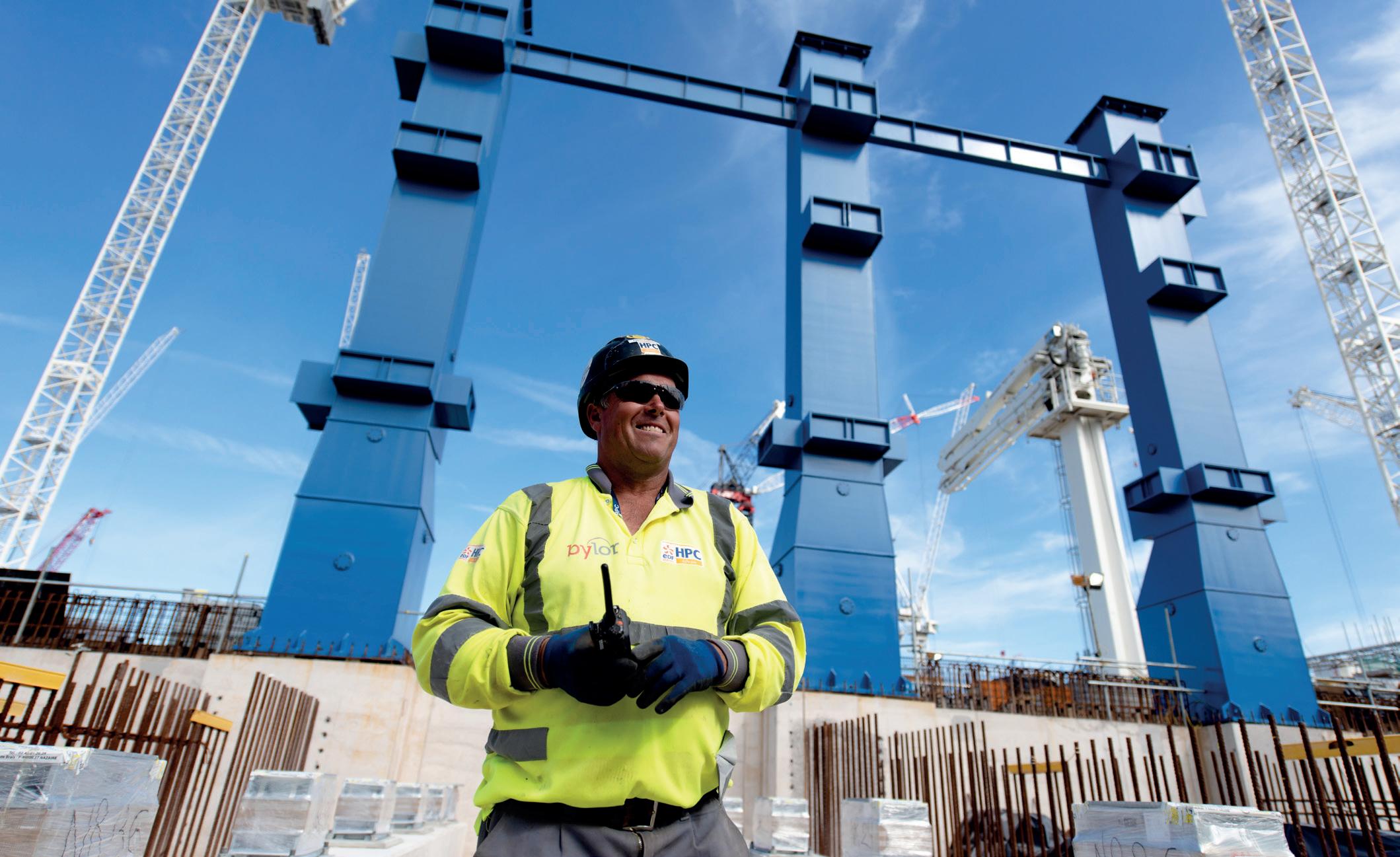
2024 | SPRING — 7
BECCY PLEASANT • HEAD OF NUCLEAR SKILLS • NUCLEAR SKILLS STRATEGY GROUP
This article was written in February 2024, ahead of the publication of the National Nuclear Strategic Skills Plan.

Partnership delivers for energy sector

A NOVEL RESEARCH PARTNERSHIP BETWEEN THE NATIONAL DECOMMISSIONING CENTRE (NDC) IN ABERDEENSHIRE, AND THE NUCLEAR DECOMMISSIONING AUTHORITY (NDA) IS DELIVERING BENEFITS TO BOTH THE OIL AND GAS AND NUCLEAR SECTORS.
The collaboration between the NDC (a partnership between the University of Aberdeen and the Net Zero Technology Centre (NZTC) and the NDA—the government body tasked with safely and cost-effectively cleaning up the UK’s oldest nuclear sites, is helping the energy sector in numerous ways including to reduce costs and emissions, improve environmental outcomes and to deliver safe, efficient and sustainable decommissioning.
Formed in 2022, the agreement is the first of its kind to bridge the nuclear and oil and gas decommissioning sectors.
It came about after three years of discussions involving the NDA, the NDC, the NZTC, regulators including the North Sea Transition Authority, and industry bodies, which sought to identify mutually beneficial opportunities through the insights and lessons learned from each sector.
Among the areas identified for joint research are the development of AI-based techniques to support risk management, sharing new technology development, analysing impact on the economy and environment and finding environmentally safe alternatives to cement—currently widely used in the plugging and abandonment of oil and gas wells and nuclear decommissioning.
Both nuclear and oil and gas decommissioning require the cutting of structures underwater and the NDC is developing an underwater laser cutter for oil and gas decommissioning. A partnership project has delivered a review on the applicability of this to nuclear decommissioning.
In addition, an AI-enabled risk live dashboard has been developed for monitoring real-time
global news to evaluate how international events can impact the nuclear industry in the short or long-term. It will be used to help risk analysts in their day-to-day jobs by scanning vast amounts of information quickly, allowing more time to identify, consider and respond to potential risks.
The partnership is also undertaking an economic impact study looking at the socioeconomic benefits of decommissioning at a local and national level and the possible impacts and benefits for associated communities. Analysis shows decommissioning activity has the potential to deliver economy-wide gains in key areas such as skills, employment, and household income, which in turn boost household consumption. The study will support stakeholder engagement helping to inform politicians and policy makers on key opportunities and enable discussions around support for skills, training and economic development to back decommissioning activities.
Another study on the fate of industrial particles in the marine environment will help provide impartial insights to the Scottish Environment Protection Agency (SEPA) and will help advisory groups at Dounreay and Sellafield with decision making.
The partnership can also utilise the unique facilities that the NDC boasts including its worldclass simulation suite. Featuring a walk-in dome with a 9m diameter screen system, four control chairs providing real-time, real-physics simulations, data modelling and data visualisation the simulator provides virtual trialling of specific technologies in real-time under different environmental conditions. Another of the NDC’s assets is its 5 x 5 x 5m freshwater immersion tank and hanger space.
8 — SPRING | 2024
PROFESSOR RICHARD NEILSON • DIRECTOR • NATIONAL DECOMMISSIONING CENTRE
▲ An integrated North Sea

“Bringing the NDC and NDA together has allowed for collaboration in new ways to achieve our joint goals of delivering safe, efficient and sustainable decommissioning.
“For year 3 of the partnership and beyond, a project to enhance the autonomous capabilities of underwater remotely operated vehicles (ROVs) used during the inspection and maintenance of nuclear ponds is envisaged. Furthermore, the expertise gathered from years of oil and gas drilling exploration will prove beneficial in the development of an underground storage facility for radioactive waste disposal.”
Sergi Arnau, Project Delivery Manager, NDC
“The real strength in the partnership is that there are numerous areas where we can collaborate to help us achieve decommissioning that is safe, secure, sustainable and cost effective.
“The value of the partnership has also been demonstrated with impartial insights provided to regulators, government, stakeholders, and advisory groups.
“By utilising technology and innovation, we can create a safer working environment for our employees, return our sites to communities for reuse earlier, and leave a more sustainable legacy for generations to come.”
Heather Barton, Interim Environment, Health and Safety Director, NDA

2024 | SPRING — 9
▲ Underwater laser cutter
▲ Clare Bond in simulator

Industry trip to Copenhagen
Copenhagen Atomics hosted a special gathering in collaboration with the Nuclear Industry Association and the British Embassy in Denmark

For many of the 40 distinguished individuals from the UK nuclear industry it was their first visit to Denmark. The itinerary kicked off with a networking reception hosted at the British Embassy in Copenhagen. Deputy British Ambassador to Denmark, Sarah Riley began introductions, relaying the importance of UK, Danish collaborations and the excitement of the potential that could be achieved with so many gathered in one place.
I outlined the objectives of the factory tour, saying “Whilst you are here, you will see not only innovation in Thorium molten Salt technology, but a disruptive approach to development. Open your mind and challenge our industry to think beyond what we know today and consider if we can do things differently. Not just faster, more efficient, cheaper. Consider a paradigm change and disrupt the status quo of nuclear. When you walk around our facilities, challenge yourself, be open to new ways, be bold, be disruptive in your thinking”.
Danish and British nuclear and non-nuclear companies discussed potential collaborations across the energy market beyond just nuclear. Whilst everyone enjoyed a typical Danish dinner, over 23 companies represented including Orsted, Northcourt Risk Specialists, the National Nuclear Laboratory and Frazer Nash Consulting ensured discussions were broad.
A large repurposed distribution centre, 11,000m2 facility, dedicated to molten salt technology met the guests as they arrived. In the lobby, a large Alfa Laval heat exchanger test piece was on display. As everyone sat and the noise quelled, Co-founder and Chairman Thomas-Jam Pedersen detailed Copenhagen Atomics approach.

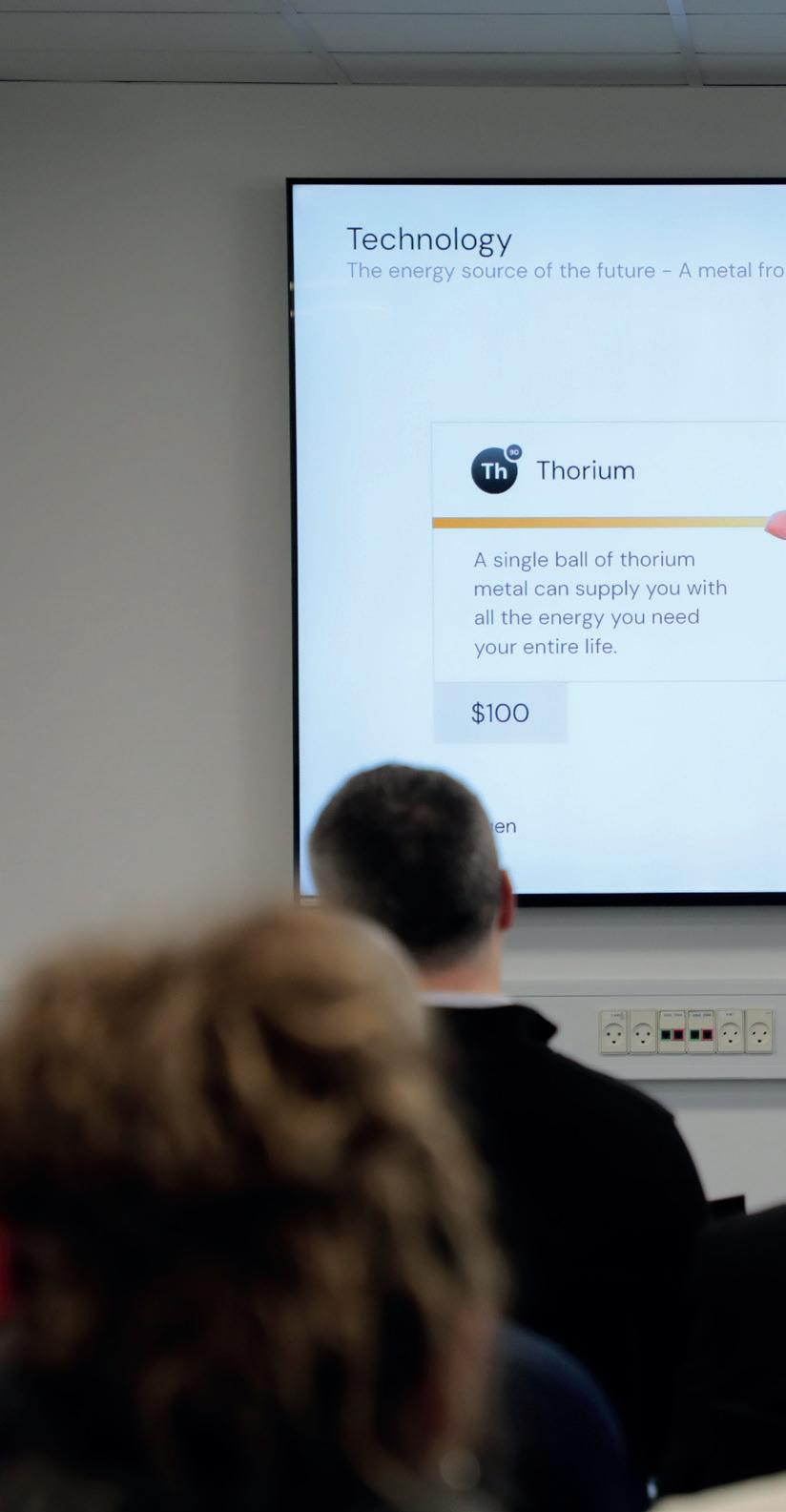
10 — SPRING | 2024
•
• UK ATOMICS
MICHAEL DRURY
MANAGING DIRECTOR
The target to produce energy at the lowest cost of energy; how only paradigm shift will enable £20/ Mwh LCOE. The audience was taken on a journey from 2014, highlighting the company growth, the technology progress, and the knowledge that has been developed with a glimpse of what to expect via the facility map.
Splitting into groups, each toured the facility, seeing welding bays, assembly areas for full scale manufacture and the latest prototype reactors that have been running with molten salt over 600 deg C. As viewers managed to get up close to the prototype they could see the inner workings of the 40 foot container and review the array of electronics, pipework, pumps, heat exchangers and the innovative “Onion” core.
Prototype operator and loop technician, Ben from Australia, was running diagnostics. He explained how Copenhagen Atomics “Break it to validate it: Design, build quickly, test, break, then back to design. Testing to failure is a key part of the development cycle. You learn a lot more, and faster than if we just stayed in the design phase.” In this way Ben explained how he has got better at what he does and how the product has improved significantly quicker.
As the groups walked past the two tonne batch production flasks for storing ultra purified salts manufactured by Copenhagen Atomics, the transformation into a state of the art reactor development facility was clear. Large structural steel framework spanned one manufacturing hall, ready for the new Thorium, Uranium laboratory walls to be installed.

Stopping at the pump manufacturing station, the visitors examined a disassembled Active Magnetic Bearing (AMB) Pump and inspected magnetic bearings that keep the rotor levitated during operation, removing wear and tear and reducing maintenance. Large CNC machines, workbenches, lathes, precision milling machines being operated, preparing the next components for assembly into the next full scale prototypes.
Spectators managed to sneak a glimpse of the processes used for refining the salts and purifying them running in the salt manufacturing hall. Copenhagen Atomics explained how they can remove the oxygen and metallic impurities within the salts to ppm levels, thereby removing the opportunity to cause corrosion.
An array of multi coloured LED lit Dynamic Flow Loops illuminated the adjacent hall. Testing an assortment of products; Flanges, welds, pumps, heat exchangers, materials, all at temperature with salts flowing around the loops and through the test pieces.
In the final bay, the Store room. Not your average shelf and dimly lit cupboard. More a huge hall with floor to ceiling stacking shelves, rows upon rows of electronics, raw materials and components awaiting manufacturing and assembly.
Walking through the app controlled doors, back to the conference centre, banks of 3D printers could be seen making the Pi Hat Control boxes that were previously seen within the prototypes. Reels of plastic, ready to be formed into the next generation of electronic housing sat alongside the silent robots printing.

2024 | SPRING — 11
The UK test programme was articulated. The search for a site, the drive to enter licensing discussion with the regulators and local stakeholder engagement. The work done to date in preparation and the work yet to be carried out. The challenges to moving forward at pace. Everyone agreed technology is not the issue, it was the things we as people can control that holds us back.
With an aim to get over 40 people to think differently, the audience was split into three groups in an interactive workshop.
1. What challenges might be faced in implementing a criticality test with respect to licensing and regulation, and how might these be overcome?
2. What value could be achieved by delivering a criticality test for the local communities, and the UK and how might they be realised?
3. What operational challenges would be faced during the project lifecycle from site commissioning to operation of a 30 day test to site decommissioning and clean up?
The sessions identified:
● Regulatory interface across multiple parties, DEFRA, ONR, EA, SEPA, NRW, DESNZ< GBN, Local planning.
● Benefits of a launch programme to enable multiple developers to enhance the speed of technology demonstration in the UK.
● Opportunities for levelling up with “forefront of innovation”, low cost energy “attracting other industries” and establishing a “Molten Salt Technology Hub.”
● The necessity for “early community engagement” and establishing longer term roadmaps that show where development and testing could realise early community benefits and “pave the way towards longer term visions.”
● Setting sustainability into the programmes for “tomorrow’s people”, creating future opportunity and recognising areas open to development that embrace innovation.
Copenhagen Atomics was thrilled to foster collaborations with esteemed partners in the UK and were appreciative of the meaningful relationships that have cultivated as a result of the factory visit. The UK’s ambitious nuclear #energy plan is particularly intriguing, and Copenhagen Atomics, UK is keen to strengthen ties with the UK even further.
Our sincere gratitude goes to the NIA for their valuable contributions in ensuring the success of this event. We extend our thanks to all the participants who travelled to join us.



12 — SPRING | 2024

The Road(Map) Ahead
The Chancellor’s Budget is looming days out from my writing deadline, so if I have missed any good news in that here, again I must beg your forgiveness. We, however, have already had a critical milestone for our industry in the publication of the Civil Nuclear Roadmap, which took us many welcome steps closer toward a proper programme of new nuclear projects.
The headline commitment, for which we advocated strongly, was to explore a further large-scale project after Sizewell C, in parallel with SMRs. We know that it is only possible to deploy twice as much nuclear as we have ever done before in the UK by using both the large-scale designs that are in operation around the Western world now, and the innovative SMR designs that Great British Nuclear is currently examining. The commitment to parallel development in particular can provide that crucial demand signal to enable the mobilisation of a larger workforce and greater investment in supply chain capability.
The task now, which we are urging on Government, is for them to pick a large-scale delivery partner for this next project. All of Europe, in the Czech Republic, Bulgaria, Poland, the Netherlands, and Romania, countries are picking partners and issuing tenders for large-scale construction. If we don’t act quickly, we risk slipping back in the queue. Instead, we should learn lessons from these tenders with all speed. I will highlight just one example for now: the Czech Republic recently raised its tender from 1 large-scale unit to 4, because it found that the per unit prices quoted for 4 were 25% lower than for a single unit. That should remind us yet again that fleet build is the way we have to go.
We have seen an encouraging spike in interest from both Conservative and Labour politicians in large-scale development and SMR development since the publication of the Roadmap. Much of it naturally centres around Wylfa, a potential site for a further large-scale development. Large or small, Wylfa is the great prize in the UK nuclear sector that we must seize if we are to come anywhere close to 24 GW. Its geology, cooling water access, grid connection, previous site preparation, and community support make in the ideal site for further development.
Nonetheless, we will need much more than Wylfa, as noted, to meet our ambition, and in that, the Roadmap again gave us more cause for optimism. It said that all developers and investors could engage in the Regulated Asset Base model as well as on
the Contract for Difference. This opens up cheaper financing, which is the most critical single factor in getting a nuclear project off the ground. Similarly, the Roadmap committed to “maximising the value of overseas regulatory assessments of reactor designs that have been completed and greater collaboration and sharing of expertise across regulatory bodies that are assessing the same technology on a similar timeframe.” This was music to our ears. For reactors large, small and advanced, design standardisation as far as possible is critical to realising cost reduction from fleet deployment. Country-specific designs changes put back the achievement of design maturity, which is a central factor in sticking to budgets and schedules. Anything that can be done to reduce these is most welcome.
Beyond this, the Roadmap outlined a series of what I might call “enabling factors” for a future programme. It targets the approval of 3-7 GW of nuclear capacity in each of 2030-2034, 2035-2039, and 2040-2044, on top of the existing target to get two projects to Final Investment Decision in the next Parliament. It clarifies that nuclear projects will have Critical National Priority Status in the planning system, to strengthen presumption in favour of low carbon generation infrastructure. Concurrently, the Government proposed adopted a “criteriabased” approach to siting policy, rather than what we have called a “menu-based” policy dependent on a prescriptive list of designated sites. Instead, developers could nominate sites that met certain criteria in order to gain a similar presumption in favour of development as exists with designation. Taken together, these steps recognise that we need a more certain cadence of project development, faster planning approval for projects, and more site on which to bring forward projects to get up to 24 GW.
There let me sound my note of caution. A programme is nothing without projects, and we still have not got a project to a Final Investment Decision since Hinkley Point C in 2016. That is far too long a gap, so the most immediate priority is the for the Government to do everything it can to get Sizewell C to FID before the next election. Sizewell C would be the first true replica, next-of-a-Kind station built in UK history. If we are serious about a programme, that is where we need to start.
I remain optimistic that we are equal to the task before us, but there is always more work to be done. Email me at lincoln.hill@niauk.org to be a part of it and thank you for your support for the NIA!
2024 | SPRING — 13
LINCOLN HILL • DIRECTOR OF POLICY AND EXTERNAL AFFAIRS • NIA

65 years of Nuclear Power in Scotland
Chapelcross, Scotland’s first Nuclear Power Plant, was first connected to the grid on 1 February 1959. Since then the country’s reactors have produced a staggering 700 TWh of electricity, more than any other clean power source in the UK. That’s enough to power every home in Scotland for 70 years, saving 400 million tonnes of carbon emissions, all from a tiny land footprint.
You can’t do that without the hard work and dedication of the people of Scotland’s nuclear industry, from the generations who have worked at the stations right through the supply chain. Together, they have done more to fight climate change than anyone else in Scottish history.
In November, the Nuclear Industry Association team visited Scotland’s last generating nuclear power plant, Torness. In his blog, Lincoln Hill, the NIA’s Director of Policy and External Affairs reflected on the people he met there who operate the cleanest, most productive, most powerful and most reliable power station in Scotland. You can read the blog on the NIA website at niauk.org/scotlands-nuclear-heroes.
14 — SPRING | 2024

2024 | SPRING — 15

Reflections on a decade of delivery in Cumbria

Businesses and those who lead them, are naturally restless. It is easy to get wrapped up in the here and now. It is easy to get carried away with what lies ahead.
We are not alone in getting excited about the prospects for the future following the launch of Great British Nuclear and the publication of the Government’s Civil Nuclear: Roadmap to 2050. An abundance of opportunities is opening for us to support infrastructure, nuclear decommissioning and new build projects in aid of the national endeavour to achieve net zero. We believe we have a vital role to play to ensure the successful delivery of these projects.
However, I am always mindful of never losing sight of past achievements and recognising progress made. We are only confident about the future because of the expertise and experience we have developed over time.
Morgan Sindall Infrastructure’s nuclear journey is intertwined with Cumbria and, naturally, Sellafield. We have now been delivering critical infrastructure in the county for just over a decade. For me and our 800strong Nuclear business unit, there is understandably immense pride in reaching this major milestone. It is testament to each and every one of
our people who have played their part and had an impact during those years. Without question, we have come a long way.
Our relationship with Cumbria started through the Infrastructure Strategic Alliance (ISA), which was initially awarded in 2012. As part of a joint venture with Arup, we continue to provide Sellafield Ltd with the capability and capacity to deliver a growing and evolving programme of infrastructure projects needed to address an ageing asset portfolio.
More recently, in 2019 we became part of the Programme and Project Partners (PPP)—a ground-breaking 20-year partnership driven by a shared purpose to revolutionise project delivery at the Sellafield site so together we can achieve the critical mission of creating a clean and safe environment for future generations. We are proud to be working as one team with Kellogg Brown and Root Ltd (KBR), Jacobs, Altrad Babcock and Sellafield Ltd to deliver a significant pipeline of major construction projects.
I will not delve into the detail of the projects we have successfully delivered during our time in Cumbria. From new facilities and stores to utility upgrades, and everything in between, our people are rightly proud
of their work and achievements. For me, our people, and the relationships they have built with our supply chain family, strategic partners and the local community are at the very heart of our journey in Cumbria.
Phrases such as “people are our business” and “collaboration is key” are so well used they have become cliché. Yet, both hold true. They have been critical to our progress and success.
When we arrived in Cumbria, we became much more than part of the business landscape—we became an active part of the wider community. Our people live, work, and contribute to the social and cultural richness of what must be one of the most beautiful places in the UK.
The same can be said of our supply chain family, which in Cumbria is predominantly SMEs. We call them family because they are a critical extension of our business, and we are proud of the fact that they have grown with us during the past decade Our relationships are built on true collaboration, trust and achieving mutual common goals because, put simply, we succeed together. Having a positive socioeconomic impact is something close to all our hearts. Working together, we amplify the impact we have—from the local investments we deliver, the job
16 — SPRING | 2024
ELDON GARNETT • MANAGING DIRECTOR • MORGAN SINDALL INFRASTRUCTURE – NUCLEAR
▲ Morgan Sindall Infrastructure has been delivering critical infrastructure in Cumbria for just over a decade
opportunities and exciting career pathways we create, to the support we give to local organisations and good causes who work tirelessly to improve the lives of local people.
Our social impact work has very much focused on helping tackle local challenges, but with an eye on the future. Our partnership with the Energy Coast University Technical College (UTC) started not long after our arrival in Cumbria. Providing governing support, we have been actively involved in its growth and evolution. Last year, we solidified our relationship with game changing investment to support the development of civil and electrical engineering facilities at the college in Lillyhall, near Workington, and create opportunities for 30 apprentices each year. The partnership is all about enhancing nuclear skills and developing a new generation of talent to drive forward the vital work taking place at Sellafield—and beyond—for decades to come.
Since laying roots in Cumbria, we have built meaningful partnerships with local schools and education providers and engaged with tens of thousands of school pupils through a variety of ways—from enriching local school curriculums and providing literacy support to work experience programmes and the increasingly popular annual Festival of Work. There is so much going on in this space, but the overall goal is simple—to raise aspirations and promote the wealth of career opportunities open to young people.
Our ‘Creating Careers in Cumbria’ programme has helped over one hundred unemployed adults to upskill, with many going on to secure jobs and, as a result, become economically active. We have rallied when times have got tough with tailored response to redundancy programmes helping dozens of people facing uncertain and worrying futures to find new roles with other local companies.
What makes me most proud is the fact our people have led from the front. They have and continue to sit on the boards and committees of local organisations pushing for positive change. They have gained an intimate understanding of local needs and brought their experience and insights to the table, along with a bucket load of passion. This has helped them to build the many collaborative initiatives in place that are continuing to make a real difference.
Part of this work has been delivered by All Together Cumbria (ATC). While it is a social enterprise owned by Morgan Sindall Infrastructure, it works with other companies based in the region to support their recruitment programmes. Ultimately, we are all facing the same skills challenges. We have a much better chance of addressing them by working together.
We do all of this for no other reason than it is the right thing to do as a responsible business. At the end of the day, we all want to leave a positive legacy.
Having grown and evolved in Cumbria, our nuclear business unit is expanding to other nuclear projects in the UK and our philosophy and approach goes with us. While our horizons have expanded, our relationship with and commitment to Cumbria will continue to go from strength-tostrength. It is so rewarding to stop and reflect on what we have achieved over the last decade. As someone who is naturally restless, I am even more excited about what the next decade holds. There is so much more to come.
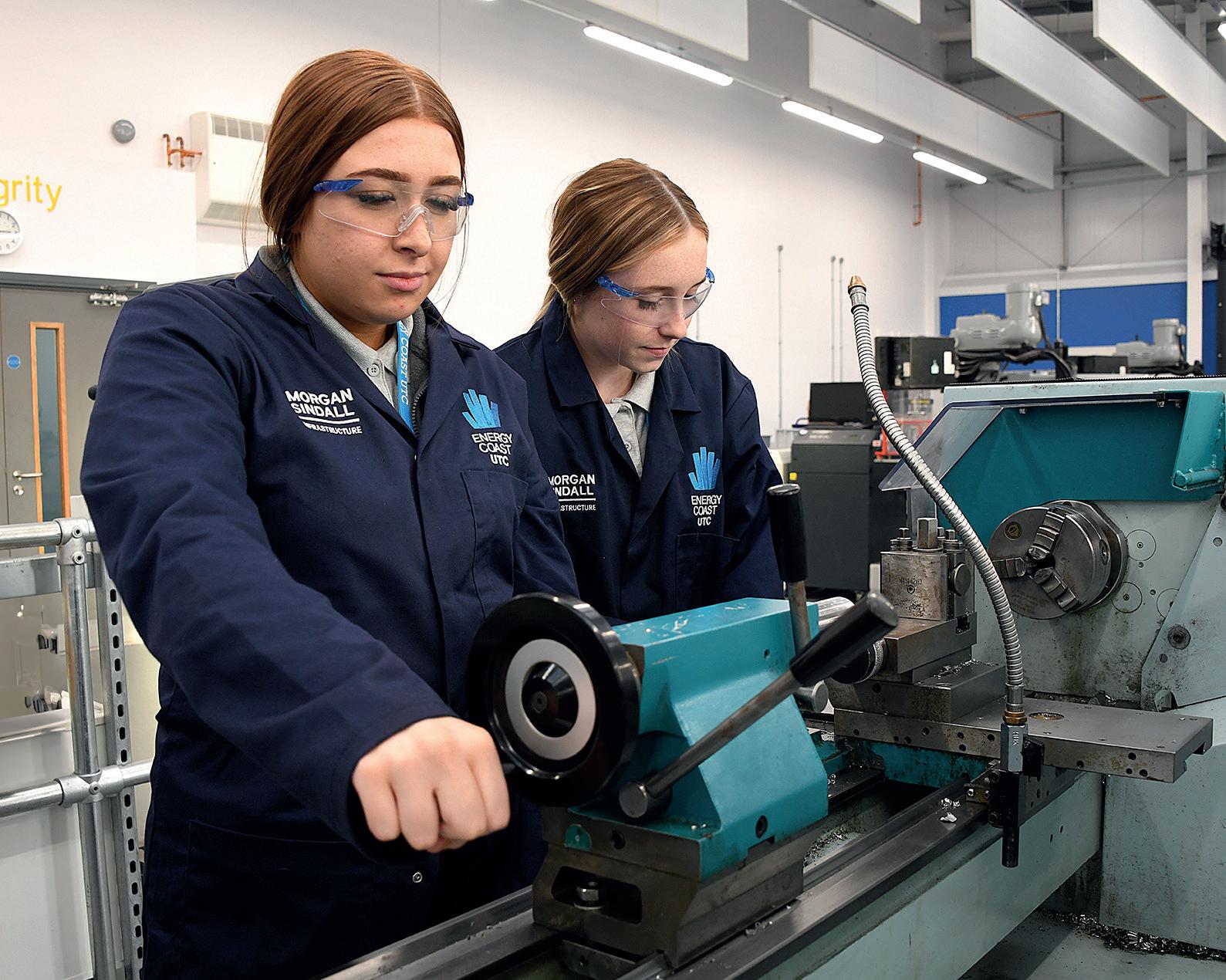


2024 | SPRING — 17
▲ The Energy Coast UTC provides technically focused education for 14-19 year old students
▲ The All Together Cumbria team - Andy Dodds, Social Enterprise Manager and Nicola Gorrill, Social Impact Manager
▲ Former Energy Coast UTC student Lauren Moore, who is now an Morgan Sindall Infrastructure apprentice
“A GDF WILL SUPPORT THE UK’S PLANS FOR THE BIGGEST NUCLEAR EXPANSION IN 70 YEARS, BRINGING SKILLED JOBS AND INVESTMENT TO THE COMMUNITY THAT HOSTS IT.”



18 — SPRING | 2024



How NWS is making the UK’s radioactive waste permanently safe, sooner
We have a fascinating nuclear history in the UK, we have pioneered the use of radio-active materials and developed a whole new industry for the ‘nuclear age’.
We’ve employed our nuclear technology for a range of purposes and as a society, we’ve all benefited from nuclear advances. Over the last 70 years, nuclear technology has been a part of our lives in the UK. It provides around 15% of the UK’s electricity and is used in industry, medicine, and defence. Today, nuclear power is viewed by the UK Government as essential to de-carbonising the grid and securing our energy supply in the future, with the aim of increasing nuclear generation by up to 4 times to 24GW by 2050.
That ambition, our history, and our continued use of radioactive materials, means we have a growing legacy of waste which we must make permanently safe. That’s where Nuclear Waste Services (NWS) comes in—to ‘close the loop’ and make sure people are protected now and long into the future.
Our ambition at NWS is to make the nation’s radioactive waste permanently safe, sooner. NWS is part of the Nuclear Decommissioning Authority (NDA) group, which is charged, on behalf of government, with cleaning up the UK’s earliest nuclear sites safely, securely, and cost-effectively.
The UK Radioactive Waste Inventory identifies 4,560,000 m3 of radioactive waste. And all of it requires careful management. There are a range of solutions available including our existing Low Level Waste Repository site and our future Geological Disposal Facility (GDF).
The Repository site has been the national disposal facility since 1959, ensuring that the UK’s low level waste is safely and permanently disposed of in a way that protects people and the environment. In other words, we know what we’re doing, and we’ve been doing it for a very long time. That includes planning for the future with our supply chain partners, we enable our customers to use a variety of waste treatment and recycling routes, or access other alternatives to disposal for waste that doesn’t need the protection of an engineered facility like ours. NWS is also responsible for delivering a Geological Disposal Facility for the UK. Investing in a GDF provides a permanent solution for the waste that cannot be sent to the Repository and removes the burden of managing our nuclear legacy from future generations—it’s the right thing to do. There is international consensus that geological disposal provides the best long-term solution for more hazardous radioactive waste, which is currently safely stored above ground at over 20 UK sites.
A GDF will support the UK’s plans for the biggest nuclear expansion in 70 years, bringing skilled jobs and investment to the community that hosts it.
Safety is our priority here. But, how will it work?
A GDF will be constructed between 200 and 1,000 metres below ground isolating and containing waste deep inside a suitable rock formation, to ensure that no harmful quantities of radioactivity can reach the surface. At this depth the waste will be protected from natural events and long-term environmental changes. The multi-barrier approach means that a series of engineered barriers will work alongside the natural geological barriers to isolate and contain the waste and radioactivity deep underground.
We are still some time away from the GDF construction phase, but we are making great progress with identifying and characterising potential sites. We are formally engaging with three communities across the country about whether hosting a facility is right for them. In Lincolnshire and Cumbria, Community Partnerships have been formed to continue the conversation. The process for finding a site is consent based, a GDF can only be built where there is a suitable site and a willing community.
It’s a long process, but we are heading in the right direction! Studies are already underway to assess site suitability and ensure a GDF can be constructed, operated, and closed safely and securely. We also consider logistics, transport, and potential local and environmental impacts. The benefits to the host community will include significant additional investment to achieve the ‘Community Vision’ that each Partnership is developing. This isn’t something we can rush—the full programme lifecycle will take generations to complete, but it’s vital.
As well as safely delivering our operations and programmes, investing in skills is a priority for us. We passionately believe in supporting the growth of our own people and the wider UK nuclear industry. We aim to nurture a thriving workforce, providing the UK with core waste management skills, a talent pipeline for waste professionals, and fulfilling careers for everyone in our business.
We’re already seeing jobs being created in the sector, it’s an exciting time! ‘Destination Nuclear’ launched in February, a first-of-a-kind national campaign designed to raise the profile of the UK nuclear sector and the opportunities available within it. Projections indicate that the UK industry will need 120,000 new jobs filled by 2030.
NWS plays a critical role, permanently dealing with our nuclear legacy and the radioactive wastes that will arise in future. It’s a responsibility we’re proud to shoulder.
Visit gov.uk/government/organisations/nuclearwaste-services to learn more abour NWS’s work towards a safer future for us all.
2024 | SPRING — 19
MARTIN WALKINGSHAW • CHIEF OPERATING OFFICER • NUCLEAR WASTE SERVICES

Wylfa is the biggest prize in Welsh history

“ IT IS ON US TO PUSH FOR POSITIVE ACTION TO GET THE SITE NAMED, TECHNOLOGIES CHOSEN, AND FINANCING COMMITTED TO SEIZE THE BIGGEST PRIZE WALES HAS EVER HAD.”
In March I was back home in Cardiff to watch Wales take on France in the Six Nations with some colleagues from the French nuclear sector. The day was a melting pot of rugby cultures, from berets and bottles of Bordeaux to Brains beer and Max Boyce belting out Hymns and Arias (shame on you if you don’t know who that is), but as we chatted rugby tactics and great teams of yesteryear, there was one topic we kept returning to: nuclear’s comeback in Wales.
Thanks to nuclear, France produces some of the cleanest power in Europe, with a whopping 56 reactors generating around 70% of the country’s electricity. There are firm plans to build another six big reactors and perhaps a further eight. The UK, by comparison, has 9 reactors providing about 14% of our electricity. None of them are in Wales, which now has the dirtiest power in Great Britain.
So the news last week that the Wylfa site on Ynys Môn is to be bought by Great British Nuclear, the UK Government body tasked with revitalising the industry, was a very significant moment in making Wales, once again, a nuclear nation.
This is the first, essential step, but there is much more work to be done. Nonetheless, the prize at the end is enormous: a new nuclear project on Ynys Môn would be the single greatest inward investment in Welsh history. Nothing else comes close.
A large-scale gigawatt station, like the one proposed by Horizon, would represent a £20 billion investment, significantly more than any other single project has brought to Wales. Wylfa would bring billions of pounds of investment specifically into Ynys Môn, North Wales and the whole Welsh supply chain.
For perspective, the Hinkley Point C project to date has already spent more than £5 billion in the South West of England. A project at Wylfa would be on a similar scale if a large-scale station was favoured
20 — SPRING | 2024
IOLO JAMES • HEAD OF COMMUNICATIONS • NIA

for the site by the UK Government. Small Modular Reactors (SMRs) of equivalent capacity would also bring billions. These would be transformational sums of money and with Ynys Môn’s GDP little over £1 billion—one of the lowest in Wales—the opportunity is far too great to squander again.
The investment would create the jobs needed to rebuild and revitalise communities on Ynys Môn, bringing back young people who have gone elsewhere in search of work. New nuclear could create up to 10,000 jobs on site during construction. Tens of thousands more jobs would be generated in the supply chain and up to 1,000 full time jobs would be sustained in operating the site for 60 to 80 years, with an annual wage bill of close to £100 million.
Workers at Hinkley Point C are earning £1,000 a week, versus an average weekly salary of £630 on Ynys Môn. These are well-paid, skilled jobs that would not only keep people on the island, but bring people back too.
I’ve spoken to young nuclear engineers who had to leave to find work on other projects after the Horizon project failed. All they ever wanted was to stay on the island, to work, and put down roots. One engineer who is now working at Hinkley Point C after starting out with Horizon said: “Nuclear for me means stability, opportunity for generations and a job for life.” He hopes that one day nuclear power generation returns to Wales and lead him back home.
Then there are the environmental benefits. New nuclear capacity at Wylfa would generate clean, reliable and Welsh power for a very long time, helping to decarbonise Wales’s electricity supply and meet its ambitious climate targets. Renewables will be key, but firm, clean power is also vital on still, cloudy days.
Wales consumes around 17 terawatt hours (TWh) of electricity per year, around 6% of the total UK
demand, but it has the lowest clean power percentage of any of the UK nations at just under 27% according to the latest official data. Scotland is at 87% due to its strong wind and nuclear output.
Wales is also reliant on burning gas for its electricity. The latest data shows that in 2022 fossil-fuel generation in Wales actually rose by over 8% year-on-year to its highest figure since 2018.
How would Wylfa help? Let’s be bold (as we need to be) and say 5 gigawatt (GW) of nuclear capacity is built on the site, either large-scale reactors, SMRs, or a mixture of both. That would produce a whopping 39 TWh of electricity per year and give north Wales the cleanest power anywhere in the UK, removing the need for around 8 billion cubic metres of gas every year and saving around 15 million tonnes of carbon emissions. 5 GW is a lot, but the site is big enough for it, be it four large reactors or double digits of SMRs.
The challenge now is to deliver. The people of Ynys Môn do not deserve another false dawn, so naturally there is scepticism whenever there is a Wylfa announcement. It is incumbent on us, however, to beat the drum for Wylfa and make it impossible for those in power, both the Welsh and UK Governments, to ignore. It is on us to push for positive action to get the site named, technologies chosen, and financing committed to seize the biggest prize Wales has ever had.
Back to the rugby and the young, inexperienced Welsh team would eventually succumb to the dominance of the French forward pack, operating much like the country’s nuclear fleet with power and reliability, and the French fans celebrated well into the night. Let’s hope that by the time they return to Wales in two years’ time, our nuclear industry will have something to shout about too.
2024 | SPRING — 21
Record-breaking JET fusion machine gets remote handling upgrade
Remote handling operators will remove over 4,000 tiles and components—some of which weigh several hundred kilograms—from the inner vessel of a record-breaking fusion machine thanks to a major robotics upgrade.
The Remote Handling Control Room at the United Kingdom Atomic Energy Authority (UKAEA) has undergone a significant upgrade, enhancing its crucial role in delivering the highest standards in fusion repurposing and decommissioning projects.
The upgrade now provides one of the most advanced robotics and remote handling systems in the world for the Joint European Torus (JET).
“We have refurbished the system so that it’s fit for the future. This has taken huge effort, more than 400,000 hours have been invested in its upgrade, which includes research and development, installation, testing, commissioning and training.”
Steve Gilligan, Programme Sponsor and Head of Decommissioning and Handling, UKAEA
The remote handling operators will be responsible for eventually removing over 4,000 individual tiles and components from JET’s inner vessel, including some that weigh several hundreds of kilogrammes.
The Remote Handling Control Room upgrades include a complete overhaul of MASCOT, a highly dextrous remote manipulator with haptic feedback, that allows the operator to feel
every action from carrying a new component to tightening a bolt.
JET is based at UKAEA’s Culham Campus in Oxfordshire. It concluded its plasma operations at the end of December 2023. It has moved to the next phase of its life cycle for repurposing and decommissioning, representing an opportunity to develop new technologies and skills in line with the Government’s published fusion strategy.
The critical testing of the inside of the tokamak is now underway and will continue throughout Spring and Summer of 2024. This process involves retrieving 60 key samples for further scientific analysis.

▲ MASCOT being used in UKAEA’s dedicated In-Vessel Training Facility ©UK Atomic Energy Authority
WISE award for nuclear physicist
Nuclear Transport Solutions’ (NTS) Principal Shielding Specialist, Liz Holland, has picked up a prestigious award for her work in the nuclear industry.
The STEM Returner award celebrates an individual, who after a career break, has returned to a science, technology, engineering or maths career and excelled as a result.
“I was incredibly proud and shocked to be announced the winner of the award and want to thank everyone at NTS who has made my return to work so easy. It can be a little daunting, after taking a five-year break from work to care for my family, to re-enter the professional environment but I’ve felt supported and encouraged throughout, I’d recommend it to anyone.
“It was also amazing to see so many other remarkable female engineers, scientists and professionals from different STEM backgrounds and I will continue to promote these fantastic careers to everyone.”
Liz Holland, Principal Shielding Specialist, NTS NTS has worked to encourage people to return to the industry after a career break by
creating a flexible and inclusive environment and Liz’s success is a testament to how these programmes can benefit individuals and organisations alike.
“Liz is a truly deserving winner and her performance has been outstanding since she joined NTS. We’re looking to create the most encouraging and inclusive environment, not just in the industry, but across all workforces to ensure we have the best people, and I’m thrilled we’re able to find such fantastic colleagues through these initiatives, huge congratulations to Liz.”
Seth Kybird, CEO, NTS
Liz’s role involves conducting radiation shielding and dose rate assessments to support the successful transportation of radioactive material, both in the UK and internationally. She is the subject matter expert for radiation shielding within the organisation, and manages a team that is responsible for modelling radiation transport through materials.
The WISE Awards celebrate outstanding women in STEM, as well as organisations making impactful changes to their gender balance.
22 — SPRING | 2024
NEWS FROM THE HUB.

Westinghouse initiates GDA process for AP300™
Westinghouse Electric Company has formally submitted an application to the Department of Energy Security and Net Zero for approval to enter the General Design Assessment (GDA) of the AP300™ Small Modular Reactor (SMR). The first step in the formal licensing process within the UK.
The AP300 SMR design utilises Westinghouse’s proven Gen III+ advanced technology, which has regulatory approval in Great Britain, the US and China, as well as compliance with European Utility Requirements standards for nuclear power plants. This brings licensing advantages and substantially reduces delivery risk for customers in the utility, oil & gas and industrial space.
This GDA application comes after the AP300 SMR was selected for the next phase of Great British Nuclear and selected by Community Nuclear Power Ltd to build four AP300 SMRs in Northeast England. These projects will also leverage Westinghouse’s 75-year history of nuclear manufacturing operations in the UK at its facility in Springfields, Lancashire.
The AP300 is the only SMR based on an advanced, large Generation III+ reactor already in operation globally—Westinghouse’s proven AP1000® technology, which is licensed in the UK Unlike every other SMR under development with first-of-a-kind technologies and risks, Westinghouse’s AP300 SMR utilises the AP1000 engineering, components and supply chain, enabling streamlined licensing and leveraging available technical skills. Together, these factors provide confidence that the first operating unit will be available in the early 2030s.
The advantageous economics of the AP300 SMR are based on robust analysis and existing project costs from AP1000 reactors already in operation or development on three continents. The AP300 SMR is under consideration by customers in the UK, Europe, and North America.
NDA Supply Chain Awards now open for entry
Ahead of the NDA’s highly anticipated group Supply Chain Event 2024, the NDA is delighted to announce its Supply Chain Awards are open for entry until 1pm Thursday 28 March.
Award winners will be announced w/c 3 June and also celebrated at the NDA Supply Chain Event in Telford on 27 June.
Find out more about the awards, including the categories, and also register your free place, here: https://ow.ly/gHAR50QwGpY.
ISEC Monitoring Systems closes deal with NG Bailey
ISEC Monitoring Systems has closed a deal with NG Bailey for the SPRS Retreatment Plant (SRP) Process CCTV system at Sellafield. This is the fourth significant contract that ISEC Monitoring Systems has signed in the UK over the last two years.
The SRP is the central nuclear waste unit in the UK and will provide safe storage of special nuclear material for at least 100 years. It is one of the first projects to be delivered through the Programme and Project Partners (PPP), a 20-year contract awarded to four organisations and the Key Delivery Partners for Sellafield’s decommissioning programme.
A turnkey CCTV system is required to allow remote monitoring of the process areas to ensure secure operations for operators at Sellafield. The contract covers design, system documentation, procurement, assembly, delivery, and on-site commissioning. ISECs customer is NG Bailey, who will in turn deliver the overall communication system. In terms of ISEC’s delivery, the contract value is £964,425.
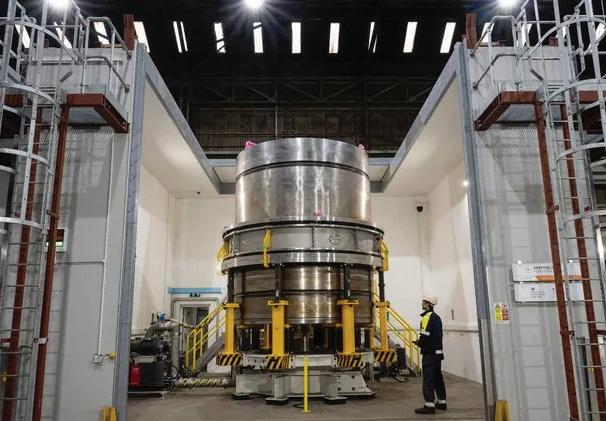
Sheffield Forgemasters makes global leap
Completion of the first full-sized Small Modular Reactor (SMR) nuclear vessel demonstrator assembly at Sheffield Forgemasters has signalled a global leap in welding technology.
The company has pioneered the industrialisation of Local Electron-Beam Welding (LEBW), and complete weld-assembly of the vessel marks a pivotal moment in welding development, taking less than 24 hours to complete four, thick, nuclear-grade welds, typically requiring a year of work to complete.
With a diameter of three meters and a wall thickness of 200mm, the construction of the vessel showcases the reliability and capabilities of (LEBW), setting a dramatic new standard for weld-joining thick-walled components, previously unrivalled in a demonstrator model.
Sheffield Forgemasters is the only company in the UK with the capability to manufacture the large forgings required for SMRs, and it now has years of developmental lead on global competitors in welding thick-walled assemblies.
The demonstration of LEBW technology’s potential opens new horizons for more efficient, low cost and less time-heavy nuclear assemblies and also has far-reaching implications for other projects which require thick-walled welded assemblies.
2024 | SPRING — 23
WELCOME TO OUR NEW MEMBERS
FYLDE COAST ENERGY LIMITED fyldecoastenergy.com
Our vision is to build a thriving and sustainable economy for the benefit of the Fylde coast community. This will be based on clean, sustainable energy, using new SMR technologies, creating long term, highly skilled employment opportunities.
ADA MODE LIMITED ada-mode.com
Ada Mode works with industrial operators in the nuclear sector to develop AI strategies, adoption roadmaps, and enable digital capabilities. Its team of consultants and engineers bring hands on practical skills to data science, engineering and deployment of projects to support analytics for complex operational problems.
BAUER TECHNOLOGIES LTD
bauertech.co.uk
BAUER Technologies Limited, a wholly owned subsidiary of the BAUER Group, is a specialist foundation contractor, providing innovative techniques and optimised designs for large retaining structures, diaphragm walls, piled foundations, cut-off walls and ground improvement solutions.
RTR GMBH & CO. KG rtr-group.com
For over 50 years, RTR GmbH & Co. KG have served the global energy sector. As an independent consultant and supplier of specialist steel materials, it works to integrate all aspects of the supply chain, allowing clients to focus on their key responsibilities.
JOHNSON ELEVANJA LIMITED brakes.ca
Johnson Elevanja design and manufacture high integrity electrical, hydraulic & pneumatic disc & drum brakes & braking systems for a variety of applications but predominantly used on cranes, hoists and conveyors, we have supplied the nuclear industry both in the united kingdom and globally for many decades.
KOREA NUCLEAR ASSOCIATION e-kna.org
KNA creates opportunities for Korean and international nuclear societies to make a brighter future together. It works with key members of the Korean nuclear industry covering the entire nuclear ecosystem, including utilities, suppliers, construction, as well as professionals in policy, finance, legal, and academia.
SEGETEX-EIF segetex.co.uk
Segetex are a leading designer and manufacturer of single or short-use protective clothing and accessories, technical wiping, be-spoke small machine covers and respiratory masks. It offers practical solutions to ensure staff, materials and equipment are protected from all forms of contamination, in challenging environments.
Delivering a bright en erg y future
UK POWER NETWORKS SERVICES
ukpowernetworksservices.co.uk
UK Power Network Services work with companies to solve energy challenges through innovative solutions, delivering resilience, cost efficiency and sustainability.
It is undertaking the electrical works and construction of electrical supplies to enable the construction of Hinkley Point C.
24 — SPRING | 2024
BODYCOTE H.I.P. LTD
bodycote.com/hot-isostatic-pressing
Bodycote operates a global Hot Isostatic Pressing (HIP) business with the largest equipment network in the world and decades of experience creating complex, high integrity components from powder metal. Its Powdermet® NNS technology produces metal components with a high degree of complexity and quality.
Not a member? To find out about the NIA and benefits of membership scan the QR code. To discuss membership options available to your company call +44 (0)20 7766 6651 or email membership@niauk.org
LESTERCAST LTD
lestercast.co.uk
Established over 50 years ago, Lestercast is a leading UK investment casting manufacturer, supplying quality castings to a wide range of industries across the world.
It manufactures castings in a vast range of non-ferrous & ferrous metals, and high temperature super alloys.
CEF
cef.co.uk
City Electrical Factors Ltd is the UK’s leading Electrical Wholesale Network with almost twice as many distribution outlets as its nearest competitor. Its group of electrical companies not only extends throughout the UK but also North America, Ireland, Spain and now Australia.
DELOITTE UK LLP deloitte.com
Deloitte is a leading global provider of audit and assurance, consulting, financial advisory, risk advisory, tax, and related services.
Deloitte currently has approximately 330,000 people in more than 150 countries and territories.
LSP
languagesolutions.fr
Language Solutions for Professionals provides tailored language solutions empower foreign civil engineers with the linguistic proficiency essential for success in this highly technical field. Bridging theory and practice, its courses integrate industry-specific vocabulary and scenarios, ensuring effectively communication.
PREMIER MODULAR premiermodular.co.uk
Premier Modular is the UK’s leading provider of modular buildings across all sectors. Since 1956, it has delivered peace of mind with 5 production lines, expert staff, and rock-solid financial stability. As the first European modular company with ESG accreditation, it is committed to building responsibly.
Dates for your diary
Nu-Tech Engineering & Technology Solutions Exhibition
Tuesday 23 April, Heysham 1 & 2 Power Stations, Lancaster
Nu-Tech Engineering & Technology Solutions Exhibition
Wednesday 15 May, Birchwood Nuclear Hub, Warrington
Space nuclear cross industry event
Tuesday 4 June
DECOM2024
Wednesday 26 June, Telford International Centre
NDA Supply Chain Event 2024
Thursday 27 June, Telford International Centre
2024 | SPRING — 25






























































